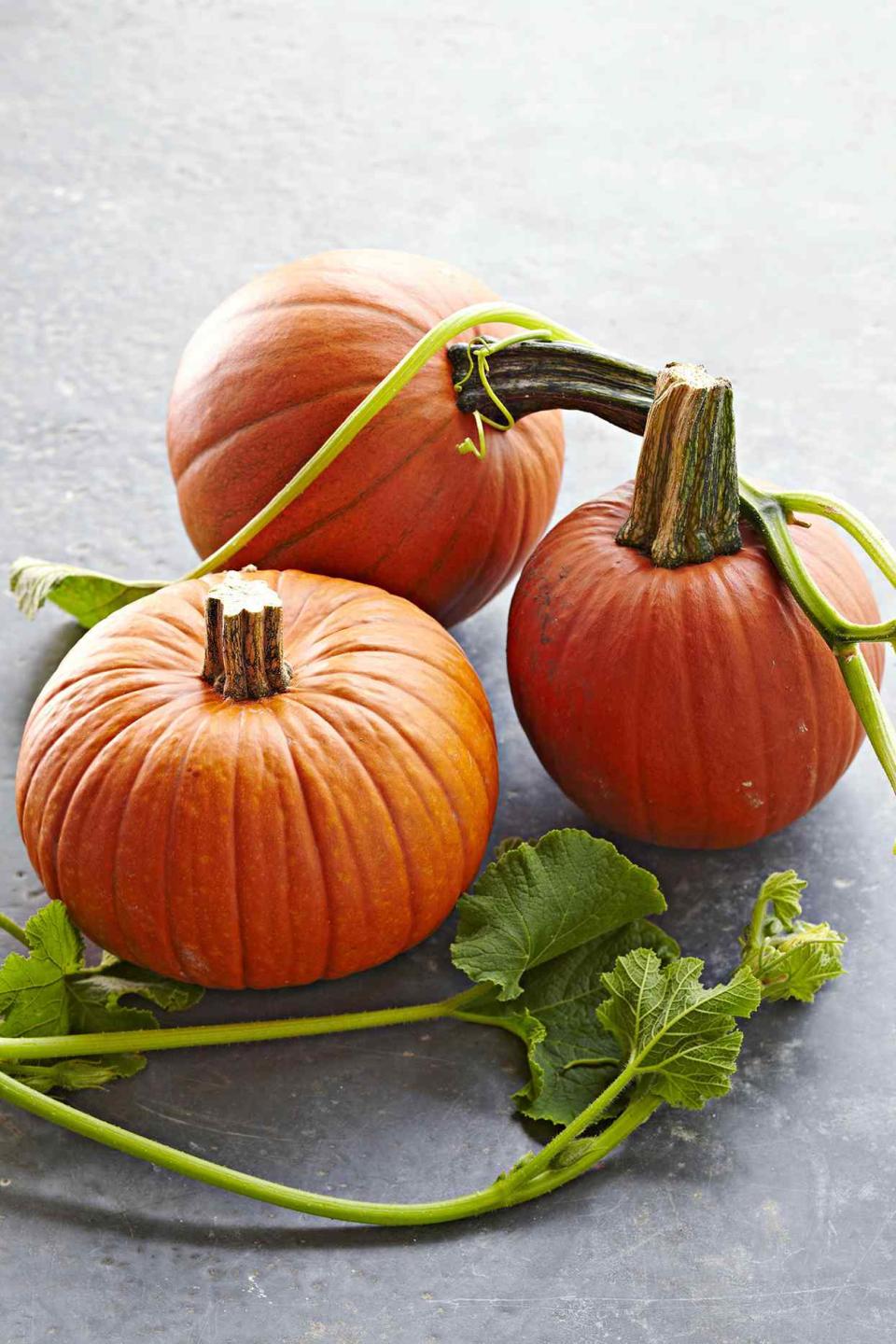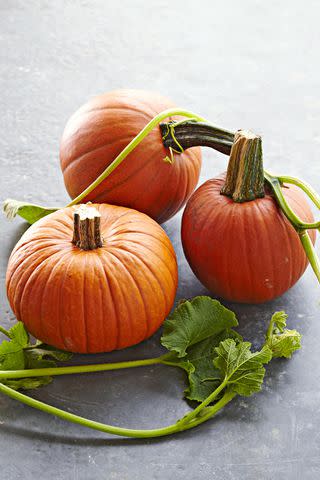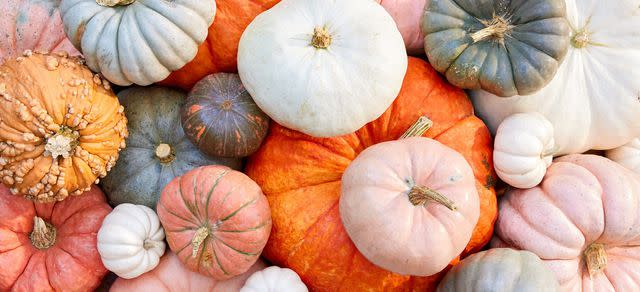How and When to Harvest Pumpkins from Your Garden
Pick your homegrown pumpkins at exactly the right time by using these essential tips and visual clues.

Pinpointing when to harvest pumpkins from your garden can feel like a riddle. Leave the brain teasers to the little goblins who visit your door for trick-or-treating and learn how to tell when pumpkins are ready to harvest.
There are several straightforward clues to look for that can help remove the mystery of determining the ripeness of pumpkins and gourds of all colors, shapes, and sizes. When harvested at the pinnacle of maturity, pumpkins can last two or more months. Whether you're growing 2-pound orbs for making pie or giant squash for jack-o-lanterns, here's what you need to know about how and when to harvest pumpkins.
Related: 26 Creative Pumpkin Carving Ideas for Cool Jack-o'-Lanterns
When to Harvest Pumpkins
Pumpkins, like watermelon, strawberries, and grapes, ripen best attached to the vine. Once removed from the vine, the sugar content of the fruit will not increase, which makes harvest timing especially important for pumpkins you want to use for baking and cooking. While sugar content isn't a factor in pumpkins used for front porch decor, maturing on the vine does help pumpkins resist rot. To figure out exactly when to harvest pumpkins, check the rind of the fruit and the plant.

Fully Developed Color
Know the mature color of the pumpkin varieties you're growing to help you gauge maturity. Most pumpkins and gourds develop their color over several weeks at the tail end of the growing season. While the fruit's exterior morphs from green to shades of orange, white, or blue-green, depending on the variety, the seeds inside are forming. When the pumpkin reaches its uniform, mature color, the seeds are also grown and capable of producing a new crop for the next season.
It's important to know when to harvest pumpkins since those picked too early might not have viable seeds, so keep that in mind if you want to save some seeds to grow next year.
Related: Yes, Growing Pumpkins in Small Spaces is Doable—Here are 7 Tips
If frost strikes early and kills the vine before the fruit can fully color up, pumpkins will continue to develop their mature color, provided they've already begun the process of coloring. The same is true for fruit on vines killed by pests or disease. As long as a pumpkin or gourd has patches of mature color, it will continue to ripen.
Dull Skin
Still-maturing pumpkins have shiny exteriors. The skin of young fruit appears bright and will reflect the sun's light. As a pumpkin matures, the rind will lose its sheen and become dull or matte-like. Avoid harvesting shiny fruits in your garden (or at the u-pick patch). Choose a dull pumpkin instead; it's more likely fully mature and will last for weeks longer on your doorstep.
Dying Squash Vines
Healthy pumpkin vines begin to yellow and die when fruit is mature. Don't be deceived by a prematurely yellowing plant; drought and pests often destroy a vine before the fruit fully matures. To prevent pests or disease from damaging any developing pumpkins, pick the fruit and put them in a warm, dry place to continue ripening.
Tough Rinds
A thick, leathery rind is a definite indicator of maturity for all types of pumpkins and gourds. The rind should be so tough that your fingernail cannot dent it. A tough rind prevents bacteria from making its way into the fruit and causing rot.
Warm, dry conditions promote hard pumpkin rinds. Encourage immature pumpkins to harden their skins by placing them in a sunny spot to cure for 7 to 10 days. Pumpkins can tolerate frost, but a freeze will quickly weaken the rind and shorten storage life. Bring them inside when a freeze is predicted.

How to Harvest Pumpkins
When it's finally time to harvest your pumpkins and gourds, use sharp pruners to cut the fruit from the vine. Leave a 3- to 4-inch stem or handle for pumpkins and a 1-inch stem for gourds. That little piece of stem is not just for looks; it creates a barrier against bacteria and fungi.
Test Garden Tip
Making your harvesting cuts on either side of the stem that attaches your pumpkin to the main vine helps increase the shelf life of your fruit. When cut this way, the stem loses less water, which means your pumpkins won't dry out as fast.
Tips for Storing Pumpkins
Maximize the life of pumpkins and gourds by cleaning the skin with a 10 percent bleach and water solution. Then rinse with water and let them dry. When using your homegrown pumpkins for fall decor, display them in a cool, dry place that protects them from moisture. Take them inside when a freeze is predicted. Store squash you plan to eat, such as pie pumpkins, in a cool, well-ventilated garage or basement where temperatures stay around 60℉.
Related: 44 Irresistible Pumpkin Desserts Starring Fall's Favorite Flavor
Frequently Asked Questions
Can you leave a pumpkin on the vine for too long?
In general, pumpkins can be left on the vine until the first autumn frost, at which point the vine will likely die, and the pumpkins should be picked. You don't typically have to worry about a pumpkin staying on the vine too long and rotting.
Should mini pumpkins be harvested at the same time as full size pumpkins?
When dealing with different sizes of pumpkins and different varietals, it's important to pay attention to clues that each pumpkin is ripe and ready to pick rather than assuming that a specific ripening timeline applies to all. Different types of pumpkins can ripen at different rates—even if they are the same size—and some smaller pumpkins can take longer to ripen than larger ones.
How long do pumpkins last once harvested?
If harvested when ripe, healthy, and disease-free, pumpkins can last anywhere from two to five months (uncarved). To help your pumpkin last, store it in a cool, dry place indoors.
For more Better Homes & Gardens news, make sure to sign up for our newsletter!
Read the original article on Better Homes & Gardens.

